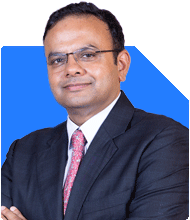Ramalingam Kalirajan |1374 Answers |Ask -Follow
Mutual Funds, Financial Planning Expert - Answered on Apr 25, 2024
He has an MBA in finance from the University of Madras and is a certified financial planner.
He is the director and chief financial planner at Holistic Investment, a Chennai-based firm that offers financial planning and wealth management advice.... more

Dear Sir, I am 43 yrs old, and want to generate a corpus of 8 crs minimum at the age of 60, My current investment is around 1.40 crs in shares, around 40 lacs in EPF, and have recently started 1 lacs SIP per month in the below scheme, Franklin India Prima fund Regular plan Growth - 25K P/m, Parag Parikh flexi cap fund Regular plan growth - 25 K PM, ICICI Prudential Small cap fund Retail plab growth - 25K PM, DSP Black Rock Mid cap fund - Regular plan growth - 10 K PM, Kotak Multicap fund regular plan growth - 15K PM, Have my regular EMI of 1.1 Lacs P/m which goes from my salary and balance is used for kids education and monthly household expenses. Please suggest is this investment OK or i need to change it, Please note will be spending almost 70~80 Lacs between 2027 to 2030 for my son higher education.
Considering your EMI commitments and impending expenses for your son's education, it's essential to assess the balance between your investments and financial responsibilities. Have you factored in inflation and potential market fluctuations in your projections? Remember, life is unpredictable, and plans may need adjustments along the way.
Your SIPs are a good start, but it might be worth reassessing the allocation to ensure it aligns with your long-term goals and risk appetite. A Certified Financial Planner would advise periodic reviews and adjustments to stay on track.
Given the upcoming educational expenses, perhaps revisiting your monthly allocations and exploring options to optimize your portfolio could be beneficial. It's all about striking the right balance between present commitments and future aspirations.
You may like to see similar questions and answers below
Abhishek Dev |57 Answers |Ask -Follow
Financial Planner - Answered on Aug 28, 2023
Ramalingam Kalirajan |1374 Answers |Ask -Follow
Mutual Funds, Financial Planning Expert - Answered on Apr 17, 2024
Ramalingam Kalirajan |1374 Answers |Ask -Follow
Mutual Funds, Financial Planning Expert - Answered on Apr 15, 2024
Ramalingam Kalirajan |1374 Answers |Ask -Follow
Mutual Funds, Financial Planning Expert - Answered on May 01, 2024
Ramalingam Kalirajan |1374 Answers |Ask -Follow
Mutual Funds, Financial Planning Expert - Answered on Apr 18, 2024
Mayank Chandel |452 Answers |Ask -Follow
IIT-JEE, NEET-UG, SAT, CLAT, CA, CS Exam Expert - Answered on May 05, 2024
Mayank Chandel |452 Answers |Ask -Follow
IIT-JEE, NEET-UG, SAT, CLAT, CA, CS Exam Expert - Answered on May 05, 2024
Mayank Chandel |452 Answers |Ask -Follow
IIT-JEE, NEET-UG, SAT, CLAT, CA, CS Exam Expert - Answered on May 05, 2024
Mayank Chandel |452 Answers |Ask -Follow
IIT-JEE, NEET-UG, SAT, CLAT, CA, CS Exam Expert - Answered on May 05, 2024
Mayank Chandel |452 Answers |Ask -Follow
IIT-JEE, NEET-UG, SAT, CLAT, CA, CS Exam Expert - Answered on May 05, 2024
Mayank Chandel |452 Answers |Ask -Follow
IIT-JEE, NEET-UG, SAT, CLAT, CA, CS Exam Expert - Answered on May 05, 2024
Mayank Chandel |452 Answers |Ask -Follow
IIT-JEE, NEET-UG, SAT, CLAT, CA, CS Exam Expert - Answered on May 05, 2024
Mayank Chandel |452 Answers |Ask -Follow
IIT-JEE, NEET-UG, SAT, CLAT, CA, CS Exam Expert - Answered on May 05, 2024
Mayank Chandel |452 Answers |Ask -Follow
IIT-JEE, NEET-UG, SAT, CLAT, CA, CS Exam Expert - Answered on May 05, 2024
Mayank Chandel |452 Answers |Ask -Follow
IIT-JEE, NEET-UG, SAT, CLAT, CA, CS Exam Expert - Answered on May 05, 2024





















